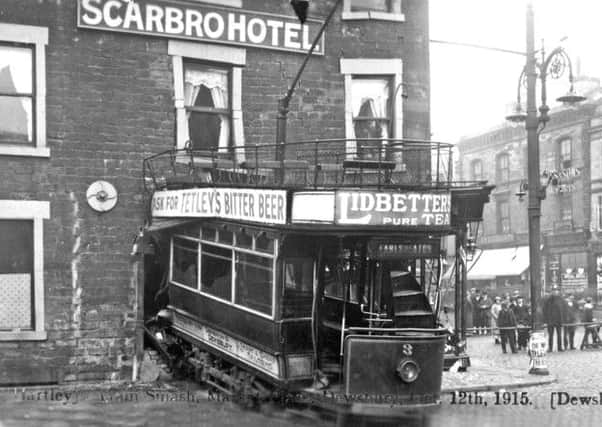Ticket to disaster for tram passengers


The UK’s worst accident occurred in Dover in 1917 when a tram ran away down Crabble Hill, killing 11 people and injuring 60. Yorkshire witnessed fatalities in a number of smashes most notably at Huddersfield 1902 (one killed); Barnsley, 1914 (two killed); Halifax, 1906 (two killed); and Leeds, 1923 (seven killed).
In many cases, British crashes were caused through slippage on the track, faulty braking systems or driver errors. A number of incidents happened during the First World War and some of these were blamed on the absence of experienced staff.
Advertisement
Hide AdAdvertisement
Hide AdOnce the brakes failed and the tram hurtled down an incline, one of the dilemmas facing passengers must have been whether or not to jump out. To have that unexpected, nail-biting decision thrust upon a passenger must have been terrifying.
Incidental features of postcards depicting tram crashes are the facial expressions of those gathered round the disaster scene – everyone eager to show their horror but all wanting to be included in the picture.
Medical help at the accident scene was sometimes very amateurish, with everyone lending a hand. Victims were treated in local houses or ferried in anything with wheels to a local hospital.
Miraculously, in three of Yorkshire’s most dramatic tram crashes only minor injuries were recorded. One of these occurred on the Yorkshire (Woollen District) Electric Tramways on Saturday afternoon January 16 1904. A few minutes before 4pm, driver Walter Dawer started car no. 55 from Thorncliffe Road end for Batley. Only a few passengers were aboard. It was noticed that the tram was running at great speed along the straight piece of track in Thorncliffe Road – much too fast to negotiate the corner in Track Road.
Advertisement
Hide AdAdvertisement
Hide AdDawer forcefully applied the handbrake but it was too late. The car left the rails and darted across the road, forcing it through a stone wall (6 feet high) which skirted the garden of the residence of Mark Oldroyd, ex MP for Dewsbury. The entire body of the car was left standing among the shrubs and the driver lay among the stones and broken glass. The front of one side of the car was completely wrecked.
The car remained in Mr Oldroyd’s garden for several days and a great number of people visited the scene. Several passengers and the driver suffered cuts and bruises.
A runaway tram completely wrecked a building at Dewsbury on Tuesday afternoon October 12, 1915. Car no. 3 – running light – was driven by John Callaghan and left the metals at the terminus in front of Dewsbury Town Hall, crashing into Hilton’s shop, adjoining the Scarbro Hotel.
Tuesday afternoon was a half day for Dewsbury traders and their assistants and it was fortunate there was no one on the premises. The driver jumped off ten yards before it hit the building, and the conductress, Maggie Sadler, also tried to escape, but both were injured. The front portion of the car smashed through the wall of the shop and was embedded inside it.
Advertisement
Hide AdAdvertisement
Hide AdAn hour later, the room above, used a drawing room and a billiard saloon, collapsed and fell on to the car and into the Market Place. Damage to the building, contents, and car was estimated as between £2,000 and £3,000. A Mrs Pinder and her daughter, Mrs Noble, were injured by a horse pulling a cart that leapt out of the way of the car.
All four people were taken to Dewsbury District Infirmary. From statements by eye-witnesses, it would appear that owing to the greasy state of the metals, through the rain, the driver lost control of the car about 100 yards from the terminus. This was the third accident in the same locality since the line opened.
Arguably Yorkshire’s most spectacular runaway tramway incident was in Scarborough on Wednesday, September 10 1923 and involved double-deck car no. 21.
The tram journey up Vernon Place hill was always a slow one and, after travelling for about 120 yards, car 21 stopped – and then began to glide backwards down the one in nine slope. Two visitors from Pudsey, Police Constable Robinson and his wife, realising that driver George Darley Smith’s desperate efforts to check the car were in vain, hurried to the platform and jumped off, falling into the roadway.
Advertisement
Hide AdAdvertisement
Hide AdApproaching the Aquarium, and with the driver still trying to make the brake act, the car left the track at a curve. It then plunged through the Aquarium glass roof landing, end on, in the ballroom 30ft below.
No one expected that driver Smith would be found alive. But, a few minutes later he was discovered among the wreckage of the tram, wedged down by a seat. He had been thrown from his end of the car to the other.
He was dazed, and bleeding from a wound to his forehead and after being attended by a nurse and ambulancemen was taken to hospital.
Pc Robinson escaped with cuts and severe shock. Mrs Robinson broke her ankle and had shock. The conductor, A. Wike, dropped off the car at the bend, and escaped injury but he was shocked.
The accident was attributed to the tram losing its grip on a problematic section of track near the top of the incline.